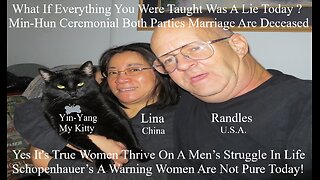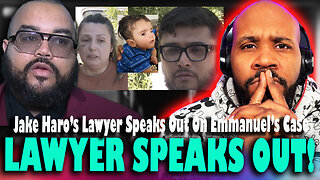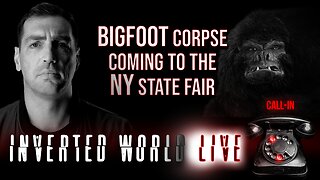Premium Only Content

Living As Intersex Person Androgynous vs Hermaphroditic Meaning Ask Questions
Androgyny and hermaphroditism are terms used to describe mixed biological sex characteristics in humans. Androgyny refers to intersex people born with congenital variations, while hermaphroditism is the possession of both male and female reproductive organs. In psychology, androgyny refers to individuals with strong personality traits associated with both sexes, combining toughness and gentleness, assertiveness and nurturing behavior. Transgender people come from every region of the United States and around the world, from every racial and ethnic background, and from every faith community. Androgynous vs Hermaphroditic Meaning - Hermaphrodite or Androgyne Defined - Hermaphroditic and Androgynous Examples - Gender - Hermaphrodite Androgynous What does androgynous mean? What is androgynous? What is the meaning of androgynous? A definition of androgynous. The various example sentences of androgynous in context for you to be able to use androgynous correctly when speaking and writing. What does hermaphrodite mean? What is hermaphrodite? What is the meaning of hermaphrodite? A definition of hermaphrodite. The video gives various example sentences of hermaphrodite in context for you to be able to use hermaphrodite correctly when speaking and writing. Michelle LaVaughn Robinson Obama (born January 17, 1964) is an American attorney and author who served as the first lady of the United States from 2009 to 2017 as the wife of President Barack Obama. She is Malia and Sasha’’s mother, but before that she was Fraser and Marian’s daughter. During her time in office she focused on supporting military families and ending childhood obesity by planting a vegetable garden on the South Lawn. A Facebook post shared – and debated – among people in Nigeria claims that Michelle Obama, wife of former US president Barack Obama, was once biologically male.
It shows two photos. One is of a younger Barack with his arm around a person who has close-cropped hair and Michelle’s face. The second shows Barack and Michelle Obama – her hair long – in a similar pose.
“His name is Michael but after going through transgender process he now answer Michelle,” the post reads. Was Michelle Obama once Michael, and has she gone through a “transgender process”? This video is claiming that First Lady Michelle Obama is secretly a transgender woman, but this time he’s adding a new twist to his conspiracy theory: that Obama had comedienne Joan Rivers killed after she joked about the first lady being trans.
A conspiracy theory going around the internet says Michelle Obama was really a man, Perhaps the conspiracy theory is believed by many because, after all, Michelle Obama appears to be more masculine in appearance than Barack Obama, and because so much is already known to be fraudulent about Barack Obama, could this also be true? Another part of the conspiracy, which seems more likely believable, is that their two daughters were adopted.
Bisexual vs Hermaphroditic vs Hermaphrodite vs Androgynous vs Epicene - Bisexual, hermaphroditic, hermaphrodite, androgynous, epicene are comparable when meaning combining male and female qualities.
The first four of these terms may be used interchangeably to mean being structurally or functionally both male and female; they may apply to all kinds of living beings and may designate a normal or an abnormal state.
Bisexual also is applied to human mental or behavioral qualities and, more precisely, designates the individual who responds sexually to members of both sexes.
Hermaphroditic and hermaphrodite when applied to human beings usually indicate primarily the presence of physical characteristics and especially of actual gonads of both sexes in the same individual and imply an abnormal state.
Hermaphrodite frequently or hermaphroditic occasionally has extended use in which it suggests the combination of two readily distinguishable and often more or less incongruous elements; thus, a hermaphrodite wagon is one made up of a two-wheeled cart with an extra pair of wheels and a rack added; hermaphrodite calipers have one caliper and one divider leg.
Androgynous in reference to human beings or to qualities or characteristics rarely connotes abnormality but rather suggests a congruous and pleasing blending.
Androgynous is also the preferred term for use in respect to deities, their attributes or appearances.
Unlike the preceding terms, epicene has no technical application to physical or functional status; however, in its often allusive reference to sex in characterizing human beings, their attributes, or the products of their being it may approach the other terms in meaning.
More often epicene suggests deficient sexuality and may imply intersexuality, effeminacy, or sex-less-ness.
In some contexts epicene loses all direct reference to sex and suggests rather the weakness inherent in deficiency which may be expressed on the one hand in extreme delicacy or on the other in utter decadence.
What is the difference between intersex, and androgynous, and transgender? I think technically it’s possible to be all three. But they are very different concepts.
Intersex: A nonstandard arrangement of sex-related body parts. (Hermaphroditism, ambiguous genitalia, chromosomal disorders, etc.) Intersex people are often immorally operated on as infants to make their bodies seem more male or female.
Androgynous: Neither totally male-like or female-like. Often used to describe someone whose appearance does not readily belie their gender. Can also mean a fashion style. An androgynous person may seem like they could easily be a boy or a girl, and you would have to ask to find out.
Transgender: The disconnect between assigned gender and real gender. Trans people often pick new names, get hormone therapy, and change their wardrobe to reflect their real gender after coming out. Ex: Janet Mock, a trans woman.
To break it down easier for the layman:
intersex is a body thing
transgender is a brain thing
androgynous is a style thing
…to be highly reductionist to the point of being inaccurate.
I am androgynous, but not nonbinary. It is possible to be nonbinary and not androgynous, though most nonbinary people I know tend to dress androgynously.
I am androgynous because I look and dress in a relatively gender neutral fashion. People look at me and go, “Is that a boy or a girl?” The answer to that question for nonbinary people is usually “Neither.”
Nonbinary refers to anyone who identifies as something other than male or female. Some nonbinary people just identify as nonbinary. Others may identify as something more specific, like agender, bigender, or genderfluid.
Nonbinary people come in all shapes, sizes, and fashion senses, so they aren’t necessarily always going to look androgynous. One of my dear nonbinary friends, for instance, has a rainbow of lipstick at their disposal and frequently rocks a skirt or dress. The next day, they might wear a binder and a flannel to go for the more androgynous look.
In summary, “nonbinary” refers to a person’s gender identity. “Androgynous” refers to their appearance and dress.
Transgender means that you were assigned male or female at birth, but feel that should be the opposite.
Androgynous means that you physically appear ambiguous as to whether you are male or female.
Intersex means that through one of many potential quirks in human physiology, you are partially male and partially female.
You can be any combination of these three groups at the same time. For example, you can be a masculine (not-androgynous) person whose body has a penis but the testicles are made of ovarian tissue (intersex) and you feel you should be a woman (transgender).
Or you could look like you could be either (androgynous), have actually female kidneys (intersex), but never questioned that you were a man (not-transgender) (examples are only using Male-At-Birth for illustrative purposes, there can be examples that are assigned Female-At-Birth, too)
Has being transgender become conflated with being intersex?
Based on my experiences over the past thirteen years that I have dealt with being intersex and trying to find answers is that yes, for the average person intersex is being treated practically the same as transgender.
People would and still assume that our experiences as an intersex person are very similar to those of a transgender person, probably because it’s all ‘that gender stuff’. Worst of all was people assuming that I would want to ‘transition’ to become a ‘normal’ male or female, clearly conflating it with gender dysphoria.
Naturally, intersex and transgender couldn’t be more dissimilar. One is physical, the other psychological (gender dysphoria). One sees infants and even adults getting ‘normalisation’ surgery (intersex genital mutilation, IGM) forced upon them, where the other has to fight to get sex-reassigment surgery.
Some do get that both terms are very different, however. That makes me somewhat happy, as I cannot count the number of times that I had to explain that I do not understand gender dysphoria, do not get why people would want to have their genitals chopped up (though I do accept it), and generally have experiences and feelings that are completely unlike those of transgender individuals.
One doctor I talked with only got this after about four appointments. Suddenly he realised that whereas transgender people already know what ‘point A’ is and just wish to reach this ‘point B’, intersex people start off by trying to figure out what this point A is (their current body configuration) and generally aren’t interested in any changes afterwards, if any are possible at all (like with CAIS, which one just has to accept).
[ Inter” sex/gender ] is where both female and male parts exist in one body, such as ovaries and testes, vagina and penis, and or genetic multiple Xs and or multiple Ys.
[ Andro gyny ] is where someone who defies sex/gender polarities in that they appear or present as a combination of masculine and feminine characteristics, or no specific sex/gender, or sex/gender ambiguous, is neither genetic nor hormones, and does not involve any brain / body sex/gender spectrum.
[ Trans* sex/gender ] is where someone’s brain and body are across sex/gender, the result of hormones in the womb before birth, just as cis* sex/gender people’s brain and body are on the same side of the sex/gender spectrum as a result of hormones in the womb before birth.
An intersex person is a person who is biologically neither male nor female. This can be due to that person having atypical chromosomes (XXY, XXX, XO, etc.), having ambiguous genitalia, or having a number of conditions that cause the development of mixed sexual characteristics.
An androgynous person is a person who presents as neither masculine nor feminine. In different terms, they appear gender neutral or ambiguous.
A transgender person is a person who does not identify as the sex they were assigned at birth. Commonly we see this as transgender women (assigned male at birth) and transgender men (assigned female at birth) but many nonbinary people consider themselves trans.
The correct term is Intersex not hermaphrodite. Some people never know or find out later in life since the outward appearance has near typical sex characteristics, but some have obvious ones. The obvious ones are often stigmatized in medical services just like transgender people are so there is a lot of overlapping experiences.
Many but not all intersex individuals do end up being transgender, but not all transgender individuals have intersex characteristics. For example I have Kleinfelter’s syndrome which is an intersex condition where my chromosomes have and extra X (female) chromosome (XXY). I was born with male genitals, but at puberty I developed feminine hips, female pubic pubic hair pattern and very tall (6′5¼”). Not everyone who has Kleinfelter’s identityfies as a woman, but I do and I transitioned years ago.
Why is it so hard for a person to make themselves androgynous and pass as neither male or female?
I LOVE androgyny, but I’ve chosen to have people read me as female, because that delivers several benefits for me:
I get the right pronouns.
Androgyny is accepted more in female persons.
Having a clear gender is a tad safer. True androgyny, where people can’t tell whether I am male or female, draws attention that I don’t want.
I can tell how close I am to the line, by how people look at me. Long looks mean people are struggling to confirm my gender, but they are assuming I’m probably an androgynous woman. Double-takes are a warning sign that I’m presenting a mixture of gender cues that people find disturbing. Stares indicate that they’ve read me as a trans woman, because it’s okay to be rude if I’m transgender! o.O
Some non-binary people seek a truly androgynous ungenderable presentation. It’s a tricky and ever-changing balance, and that balance changes depending on activity, situation, location, present company and the particular observer.
Earlier in my gender transition, there was one time where one person gendered me female, and another person gendered me male, inside the same conversation. Some androgynous people have those sorts of conversations regularly, and enjoy collecting a range of different pronouns each day.
Trick is, mostly the pronouns those androgynous peeps get is “he” or “she”. Gendered social etiquette assumes that a gender must be chosen, so most people will make a guess. Every once in awhile, they’ll get a “they” from someone they never met before, or someone will change pronouns on them mid-conversation, and they privately think to themselves, “Woo hoo! Recognised!” :-)
That’s the pinnacle of androgyny.
How can I determine someone's gender if their hair, voice, and body are gender-neutral?
That pinnacle of androgyny is hard to achieve, because it requires an exact 50/50 balance of gender cues, anatomical, grooming, clothing, body language, voice, activity, situation, location, and present company, and then adjusted to fit the gender expectations of a particular observer.
When you're intersex and you have both parts, where are they located?
I’m a hermaphroditic intersex person (medical term is ‘true hermaphrodite’), and I have both male and female reproductive organs in the usual places. There’s nothing difficult about this, biologically speaking.
After all, every woman has a penis, albeit a very small and underdeveloped one (the clitoris). My labia did get merged into a scrotum, containing (undeveloped) testicles, the latter of which got surgically removed a few years back. I have a (closed-off) vagina in the usual location. One day I hope to find a surgeon who can reconstruct the vagina and labia, recycling the skin of the now empty scrotum.
With a body like mine, it’s easy to see just how similar ‘male’ and ‘female’ bodies are. After all, they use the same template, simply following a different course during development based on hormonal and genetic triggers (like the SRY gene).
Everything would be so easy if a) it was simply a medical issue and not political, and if we b) had a proper somatic method on diagnosing if the patient’s BSTc is alike that of the opposite sex. I mean, like running a CAT scan and telling either “Yes, your brain indeed manifests the symptoms of transsexualism, here is the cover letter for treatment” or “We could not find the symptoms of transsexualism, so your case must be of something else, so we will divert you to further examination”.
Unfortunately, the Leftists, the woke people and the trans people themselves have made it political and made an immense disservice to themselves - so much that term “truscum” has emerged as a slur to those who consider it as a purely medical phenomenon, and many genuine transsexuals keep distance to the trans-activists and do not want to be in any dealings with them.
It has led also in the situation where transsexualism has become some kind of fashion diagnosis - any teen, usually biological girls, who do not find themselves fitting in the social role of their biological sex identify as transsexuals and demand treatment. Since transsexualism (if there are no somatic intersex symptoms) can be diagnosed reliably only on adults, it is indescribable malpractice to allow those addled teenagers to poison themselves with hormones and cause permanent damage. I mean, some people really need to be protected from themselves.
It appears transsexualism is today a political issue - not any more a medical issue - and I find it extremely alarming. Simply because I am an Atheist and Materialist, I reject any ideologies, and my conviction is that any medical anomalies should be treated medically, not politically.
The another unfortunate thing is that the somatic symptom of transsexualism - the BSTc anomaly in brain - can be reliably diagnosed only on a dead person as the diagnosis method is destructive. So the only way to diagnose transsexualism is the patient’s subjective feelings (plus any probable history on symptoms of inter-sexualism) and the separative diagnosis. And, alas, some 90% of those who suspect themselves to be transsexuals aren’t. They are something else - self-denying homosexuals, transvestites, fetishists, novelty seekers, schizophrenics, autists - and letting them to undergo the treatment is a launch of a catastrophe. See Autism, Puberty, and Gender Dysphoria
Sex change is a valid treatment for those who are genuine TSes. For others, it is a recipe to disaster. If you are not a transsexual before the surgery, you sure are one after it, said my F2M friend. And it should always be the last resort when nothing else works - never the first option. I mean, it is ethically wrong to mutilate healthy genitals unless it is essentially necessary to save a) sanity b) life.
I wrote some time ago that the transsexuals and inter-sexuals overlap heavily, and that many sex changes are actually due to misassigned gender in infancy - intersexual individuals identify to the opposite sex to that in which they were “corrected” as infants.
But there are many inter-sexuals who are just happy as what and who they are and do not want any corrective surgery - they prefer to be “natural” (if this term can be used here). If we accept transsexualism and inter-sexualism as a continuum, we must then also accept that there will be many people who identify themselves as transsexuals but do not opt for surgery. Perhaps the hormones would be enough to maintain sanity and mental balance?
This, however, also creates an ethical problem. Could such individuals use the toilets and locker rooms of the opposite sex? In Finland it is considered good behavior to use the wheelchair-marked toilet as long as you are pre-op. All in all, this is a conundrum, and I would like to see the medical professionals’ opinion here.
The whole thing kinda sucks. And I’m not going to rail about political issues. I’ll talk about biological ones.
Having a vagina/uterus f*cking sucks. It really does. All you do is bleed out of it all the time and there is the constant risk of pregnancy and you have to go through all these hoops to avoid it. Of course, you could choose to “not have sex,” because having sex as a woman makes you a f*cking slut, right? (But men can have it whenever they want because, yay men! High five, bro!) So if you get pregnant it is TOTALLY your fault and it’s not like there was another person involved at all with it, right? Totally you. You’re a slut.
I hate it totally. If I could hit a switch to change my sex to male I absolutely would. I would completely go and get high fives from my bros. And yes, I am aware that there are negatives to being male, but I really do think I’d be a better man than a woman. I absolutely do not want to have children, so my reproductive system is actually totally useless. It’s just a fucking annoyance.
Being a woman means that I am fundamentally worth less than a man and if I get pregnant it’s totally my fault because I’m a whore. I dislike it totally, and I would swap it if I could. I don’t not identify as female, so I am not trans, but I just hate it. I hate it deeply, and I am overall very resentful due to biology. Which is nobody’s fault, but I still do hate it. Every time I bleed, which is every month, I f*cking hate it.
That’s all. That’s what it means to me. Essentially, disgust.
Thought Exercise: Thinking About Your Own Gender
It can be difficult for people who are not transgender to imagine what being transgender feels like. Imagine what it would be like if everyone told you that the gender that you’ve always known yourself to be was wrong. What would you feel like if you woke up one day with a body that’s associated with a different gender? What would you do if everyone else—your doctors, your friends, your family—believed you’re a man and expected you to act like a man when you’re actually a woman, or believed you’re a woman even though you’ve always known you’re a man?
Yes. It was just a feeling when I was young, though I did not know a name for it. I was openly discussing my feelings that I was actually a girl when I was 9. Then I was a teenager and I developed some female features and boobs as I went through puberty. I was freaked out, I am supposed to be a boy after all! My doctor made light of it and administered testosterone to stop the development in that direction. I started to question everything at that point.
After learning of the term “transsexual” in the 80’s, I realize that is what I must be…their stories were totally familiar! In the early 90’s, I was diagnosed as such by my therapist. Did not do anything about it until the late 90’s when I started to transition. When I began estrogen, my doctor had discovered that I already had high levels and lower than average levels of testosterone. My doctor was not concerned too much so I kind of did not worry. I would find out later that he thought it was the result of self medication, but I had never done that…so it was my body doing it.
10 years later, my therapist started to really delve into how my childhood was and how I worked through my dysphoria. It occurred to us that I had had some physical development things that had been happening to my body throughout all my years. She suggested I talk with my doctor about looking for possible intersex conditions that could be contributing to my feeling.
And that led me to having my doctor sort of delve into things. He tested this and that and came back with two distinct things that could explain my mixed male/female “biology”, one likely caused by “chemical exposure” (read, medication my mom took during pregnancy) in the womb and the other (related) was a pituitary malfunction that caused my system to break testosterone down into estrogen. Whala! I have an intersex condition and had no clue for a majority of my life even if all the signs were there from like 14 on.
I have been part of a support group and it seems like most of us had clues throughout our lives, but not always do the dots line up straight.
Being gay is about sexuality while being transgender is about sexual identity or gender identity.
If you're gay (not “a gay,” it's an adjective, not a noun), you identify with your own gender/ biological sex and are attracted to others of the same sex. For eg. A gay man knows and accepts that he is a man but he is attracted to other men, a lesbian knows and accepts that she is a woman but she feels attracted to other women.
Transsexual or transgender on the other hand is when you DO NOT identify with the biological gender assigned to you. It's sort of like a package-ing problem (pun intended). You’re an Oreo in a Marie box and you want to change the box. There's nothing wrong with the box, it's just not your box, you want nothing to do with it.
This isn't a simple case of tomboys in jeans and boys who like wearing skirts. It runs even deeper than that. No one chooses the to be other gender, that's just the default setting of their brain. Simply put, your mind does not identify with the gender assigned to you at birth. Something got messed up and you got the wrong body. There ARE physical features in the brain that don't match the body; it's the same as straight & gay brains being different.
Is it scientifically true that the brain of a transgender person is similar to the brain of the gender they identify with?
It is a mismatch on such an innate level that you have to get gender reassignment surgery (they cut you up & replace whatever genitalia you have with those of the gender you identify in the bottom-surgery and either implant or remove breasts in the top-surgery). There are many cases where you develop psychological problems otherwise and might even get suicidal. Watch the video at the end to get an idea about how traumatic it can be (it's a short film, SFW.)
After surgery and hormone replacement therapy, you do have a body that matches with your self-concept and your gender identity (your voice might still not match, depends), but those new organs don't function exactly like the real thing. A trans-man has a functional penis and a scrotum for display, but he can't have children because his body doesn't produce sperm. A trans-woman has a clitoris and a vagina, but she cannot get pregnant because her body doesn't have a uterus or ovaries and no periods. In the future, it may be possible to transplant a functional uterus or grow one using stem cells, but not with today's technology. It's basically an external change. They cut off the male genitalia and make it look female, and extend the female genitalia to make it look male, add breasts or remove them.
If you're gay, you're attracted to your own sex by default. But if you're trans, that doesn't say anything about who you'd rather sleep with.
If, for example, you’re a post-op trans-man (biological female who identifies as male and got surgery), or even if you're pre-op, you may be attracted to men or women or both. There's no telling.
If you're biologically female, you're straight if you're attracted to men. But you identify as male so you're gay. So then you're a gay trans-man.
If you're biologically male, you're straight if you're attracted to women. But you identify as female so you're a lesbian. Then you're a lesbian trans-woman or trans lesbian.
If you're biologically female and are attracted to other women, you're a lesbian. But you identify as male, so you're straight. Then you're a straight trans-man.
If you're biologically male and you're attracted to men, you're gay. But you identify as female, so you're straight. That's a straight trans-woman.
If you're attracted to both, you're bisexual before & bisexual after. Bi, bi, till you die~ Hope that you understood the difference :)
Feel free to ask me if you still have any doubts.
Frequently Asked Questions about Transgender People Transgender people come from every region of the United States and around the world, from every racial and ethnic background, and from every faith community. Transgender people are your classmates, your coworkers, your neighbors, and your friends. With approximately 1.4 million transgender adults in the United States—and millions more around the world—chances are that you've met a transgender person, even if you don't know it.
What does it mean to be transgender?
Transgender people are people whose gender identity is different from the gender they were thought to be at birth. “Trans” is often used as shorthand for transgender.
When we're born, a doctor usually says that we're male or female based on what our bodies look like. Most people who were labeled male at birth turn out to actually identify as men, and most people who were labeled female at birth grow up to be women. But some people's gender identity – their innate knowledge of who they are – is different from what was initially expected when they were born. Most of these people describe themselves as transgender.
A transgender woman lives as a woman today, but was thought to be male when she was born. A transgender man lives as a man today, but was thought to be female when he was born. Some transgender people identify as neither male nor female, or as a combination of male and female. There are a variety of terms that people who aren't entirely male or entirely female use to describe their gender identity, like non-binary or genderqueer.
Everyone—transgender or not—has a gender identity. Most people never think about what their gender identity is because it matches their sex at birth.
Being transgender means different things to different people. Like a lot of other aspects of who people are, like race or religion, there's no one way to be transgender, and no one way for transgender people to look or feel about themselves. The best way to understand what being transgender is like is to talk with transgender people and listen to their stories.
How does someone know that they are transgender?
People can realize that they're transgender at any age. Some people can trace their awareness back to their earlier memories – they just knew. Others may need more time to realize that they are transgender. Some people may spend years feeling like they don't fit in without really understanding why, or may try to avoid thinking or talking about their gender out of fear, shame, or confusion. Trying to repress or change one’s gender identity doesn’t work; in fact, it can be very painful and damaging to one’s emotional and mental health. As transgender people become more visible in the media and in community life across the country, more transgender people are able to name and understand their own experiences and may feel safer and more comfortable sharing it with others.
For many transgender people, recognizing who they are and deciding to start gender transition can take a lot of reflection. Transgender people risk social stigma, discrimination, and harassment when they tell other people who they really are. Parents, friends, coworkers, classmates, and neighbors may be accepting—but they also might not be, and many transgender people fear that they will not be accepted by their loved ones and others in their life. Despite those risks, being open about one’s gender identity, and living a life that feels truly authentic, can be a life-affirming and even life-saving decision.
What's the difference between sexual orientation and gender identity?
Gender identity and sexual orientation are two different things. Gender identity refers to your internal knowledge of your own gender—for example, your knowledge that you're a man, a woman, or another gender. Sexual orientation has to do with whom you’re attracted to. Like non-transgender people, transgender people can have any sexual orientation. For example, a transgender man (someone who lives as a man today) may be primarily attracted to other men (and identify as a gay man), may be primarily attracted to women (and identify as a straight man), or have any other sexual orientation.
What's the difference between being transgender and being intersex?
People sometimes confuse being transgender and being intersex. Intersex people have reproductive anatomy or genes that don’t fit typical definitions of male or female, which is often discovered at birth. Being transgender, meanwhile, has to do with your internal knowledge of your gender identity. A transgender person is usually born with a body and genes that match a typical male or female, but they know their gender identity to be different.
Some people think that determining who is male or female at birth is a simple matter of checking the baby's external anatomy, but there's actually a lot more to it. Every year, an estimated one in 2,000 babies are born with a set of characteristics that can't easily be classified as "male" or "female." People whose bodies fall in the vast continuum between "male" and "female" are often known as intersex people. There are many different types of intersex conditions. For example, some people are born with XY chromosomes but have female genitals and secondary sex characteristics. Others might have XX chromosomes but no uterus, or might have external anatomy that doesn't appear clearly male or female.
While it's possible to be both transgender and intersex, most transgender people aren't intersex, and most intersex people aren’t transgender. For example, many intersex people with XY (typically male) chromosomes but typically female anatomy are declared female at birth, are raised as girls, and identify as girls; in fact, many of these girls and their families never even become aware that their chromosomes are different than expected until much later in life. However, some intersex people come to realize that the gender that they were raised as doesn’t fit their internal sense of who they are, and may make changes to their appearance or social role similar to what many transgender people undergo to start living as the gender that better matches who they are.
What is the difference between being transgender and being gender non-conforming?
Being gender non-conforming means not conforming to gender stereotypes. For example, someone’s clothes, hairstyle, speech patterns, or hobbies might be considered more "feminine" or "masculine" than what's stereotypically associated with their gender.
Gender non-conforming people may or may not be transgender. For example, some women who were raised and identify as women present themselves in ways that might be considered masculine, like by having short hair or wearing stereotypically masculine clothes. The term “tomboy” refers to girls who are gender non-conforming, which often means they play rough sports, hang out with boys, and dress in more masculine clothing.
Similarly, transgender people may be gender non-conforming, or they might conform to gender stereotypes for the gender they live and identify as.
What does it mean to have a gender that's not male or female?
Most transgender people are men or women. But some people don't neatly fit into the categories of "man" or "woman" or “male” or “female.” For example, some people have a gender that blends elements of being a man or a woman, or a gender that is different than either male or female. Some people don't identify with any gender. Some people's gender fluctuates over time.
People whose gender is not male or female may use many different terms to describe themselves. One term that some people use is non-binary, which is used because the gender binary refers to the two categories of male and female. Another term that people use is genderqueer. If you're not sure what term someone uses to describe their gender, you should ask them politely.
It's important to remember that if someone is transgender, it does not necessarily mean that they have a "third gender." Most transgender people do have a gender identity that is either male or female, and they should be treated like any other man or woman.
For more information about what it's like to have a gender other than male or female or how you can support the non-binary people in your life, read NCTE's guide Understanding Non-Binary People.
Why don’t transgender people get counseling to accept the gender they were assigned at birth?
Counseling aimed at changing someone’s gender identity, sometimes known as conversion therapy, doesn’t work and can be extremely harmful. The belief that someone’s gender identity can be changed through therapy runs counter to the overwhelming consensus in the medical community. Telling someone that a core part of who they are is wrong or delusional and forcing them to change it is dangerous, sometimes leading to lasting depression, substance abuse, self-hatred and even suicide. Because of this, a growing number of states have made it illegal for licensed therapists to try to change a young person’s gender identity (laws apply to those under 18). However, many transgender people find it helpful to get counseling to help them decide when to tell the world they are transgender and deal with the repercussions of stigma and discrimination that comes afterward.
What does "gender transition" mean?
Transitioning is the time period during which a person begins to live according to their gender identity, rather than the gender they were thought to be at birth. While not all transgender people transition, a great many do at some point in their lives. Gender transition looks different for every person. Possible steps in a gender transition may or may not include changing your clothing, appearance, name, or the pronoun people use to refer to you (like “she,” “he,” or “they”). Some people are able to change their identification documents, like their driver’s license or passport, to reflect their gender. And some people undergo hormone therapy or other medical procedures to change their physical characteristics and make their body better reflect the gender they know themselves to be.
Transitioning can help many transgender people lead healthy, fulfilling lives. No specific set of steps is necessary to “complete” a transition—it’s a matter of what is right for each person. All transgender people are entitled to the same dignity and respect, regardless of which legal or medical steps they have taken.
What are some of the official records transgender people may change when they're transitioning?
Some transgender people make or want to make legal changes as part of their transition, like by changing their name or updating the gender marker on their identity documents.
Not all transgender people need or want to change their identity documents, but for many, it's a critical step in their transition. For many transgender people, not having identity documents like driver's licenses or passports that match their gender means that they might not be able to do things that require an ID, like getting a job, enrolling in school, opening a bank account, or traveling. Some transgender people who use an ID that doesn't match their gender or their presentation face harassment, humiliation, and even violence.
Transgender people may need to change a number of documents in order to live according to their gender identity, such as their:
Driver’s license
Social Security card
Passport
Bank accounts and records
Credit cards
Paychecks and other job-related documents
Leases
Medical records
Birth certificate
Academic records
It's important to know that not all transgender people be able to make the changes they need to their IDs and other official documents. Unfortunately, these changes are often expensive, burdensome, and complicated, putting them out of reach for many people. For example, some states still require proof of surgery or a court order to change a gender marker. In many states, the process can be time-consuming and involve many steps, or cost hundreds of dollars. As a result, only one-fifth (21%) of transgender people who have transitioned have been able to update all of their IDs.
NCTE works to modernize all of these outdated requirements. States are increasingly adopting more accessible and straightforward policies for changing one's name and gender marker.
To find out the requirements for updating a driver’s license or birth certificate in your state or territory, as well as get information on changing federal IDs and records, visit NCTE’s ID Documents Center.
What medical treatments do some transgender people seek when transitioning?
Some, but not all, transgender people undergo medical treatments to make their bodies more congruent with their gender identity and help them live healthier lives.
While transition-related care is critical and even life-saving for many transgender people, not everyone needs medical care to transition or live a fulfilling life.
Different transgender people may need different types of transition-related care. People should make decisions about their care based on their individual needs. Medical procedures can include:
hair growth or removal treatments
hormone therapy
various surgeries to make one's face, chest, and anatomy more in line with one's gender identity
While not everyone needs transition-related medical treatments, there is an overwhelming consensus in the medical community that they are medically necessary for many transgender people and should be covered by private and public insurance. Every major medical organization in the United States has affirmed that transition-related medical care is safe and effective, and that everyone who needs it should be able to access it. Unfortunately, this critical care is often denied by insurance companies, often in spite of state and federal laws.
What is gender dysphoria?
For some transgender people, the difference between the gender they are thought to be at birth and the gender they know themselves to be can lead to serious emotional distress that affects their health and everyday lives if not addressed. Gender dysphoria is the medical diagnosis for someone who experiences this distress.
Not all transgender people have gender dysphoria. On its own, being transgender is not considered a medical condition. Many transgender people do not experience serious anxiety or stress associated with the difference between their gender identity and their gender of birth, and so may not have gender dysphoria.
Gender dysphoria can often be relieved by expressing one’s gender in a way that the person is comfortable with. That can include dressing and grooming in a way that reflects who one knows they are, using a different name or pronoun, and, for some, taking medical steps to physically change their body. All major medical organizations in the United States recognize that living according to one’s gender identity is an effective, safe and medically necessary treatment for many people who have gender dysphoria.
It's important to remember that while being transgender is not in itself an illness, many transgender people need to deal with physical and mental health problems because of widespread discrimination and stigma. Many transgender people live in a society that tells them that their deeply held identity is wrong or deviant. Some transgender people have lost their families, their jobs, their homes, and their support, and some experience harassment and even violence. Transgender children may experience rejection or even emotional or physical abuse at home, at school, or in their communities. These kinds of experiences can be challenging for anyone, and for some people, it can lead to anxiety disorders, depression, and other mental health conditions. But these conditions are not caused by having a transgender identity: they're a result of the intolerance many transgender people have to deal with. Many transgender people – especially transgender people who are accepted and valued in their communities – are able to live healthy and fulfilling lives.
Why is transgender equality important?
Transgender people should be treated with the same dignity and respect as anyone else and be able to live, and be respected, according to their gender identity. But transgender people often face serious discrimination and mistreatment at work, school, and in their families and communities.
For example, transgender people are more likely to:
Be fired or denied a job
Face harassment and bullying at school
Become homeless or live in extreme poverty
Be evicted or denied housing or access to a shelter
Be denied access to critical medical care
Be incarcerated or targeted by law enforcement
Face abuse and violence
For statistics about these types of discrimination, go to the National Transgender Discrimination Survey page.
Living without fear of discrimination and violence and being supported and affirmed in being who they are is critical for allowing transgender people to live healthy, safe, and fulfilling lives. In recent years, laws, policies and attitudes around the country have changed significantly, allowing more transgender people than ever to live fuller, safer, and healthier lives.
The transgender movement is part of a long tradition of social justice movements of people working together to claim their civil rights and better opportunities in this country. These challenges are connected. Discrimination that transgender people of color face is compounded by racism, and lower-income transgender people face economic challenges and classism. NCTE believes that progress towards transgender equality requires a social justice approach that fights all forms of discrimination.
-
 27:25
27:25
What If Everything You Were Taught Was A Lie?
2 days agoYes Women Thrive On A Men’s Struggle In Life Schopenhauer’s Warning Women Are Not Pure Today
1.71K2 -
 2:05:30
2:05:30
Side Scrollers Podcast
18 hours agoEveryone Hates MrBeast + FBI Spends $140k on Pokemon + All Todays News | Side Scrollers Live
101K11 -
 11:06
11:06
The Pascal Show
13 hours ago $1.06 earned'THEY'RE GETTING DEATH THREATS!' Jake Haro's Lawyer Breaks Silence On Emmanuel Haro's Disappearance!
8.89K -
 LIVE
LIVE
Lofi Girl
2 years agoSynthwave Radio 🌌 - beats to chill/game to
391 watching -
 2:19:32
2:19:32
Badlands Media
1 day agoDEFCON ZERO Ep. 005: False Flags, Cyber Fronts & Global Power Plays
146K58 -
 2:35:23
2:35:23
FreshandFit
8 hours agoWhy Black Men Don't Date Black Women Debate
38.6K36 -
 2:03:42
2:03:42
Inverted World Live
12 hours agoBigfoot Corpse Coming to the NY State Fair | Ep. 94
108K26 -
 6:16:23
6:16:23
SpartakusLIVE
12 hours ago$1,000 Pistol Challenge || #1 ENTERTAINER of The EONS Eradicates BOREDOM
85.1K2 -
 2:33:37
2:33:37
TimcastIRL
10 hours agoTrump Orders Review of Smithsonian For Being Woke & Out of Control | Timcast IRL
188K78 -
 3:09:10
3:09:10
Barry Cunningham
13 hours agoPRESIDENT TRUMP HAS TAKEN THE MONSTER AWAY FROM THE LEFT! HORROR STORIES WON'T WORK ANYMORE!
84.2K81